Kauhava Knife Double Sheath Horse Head Made In Finland Set Of 2 Knives
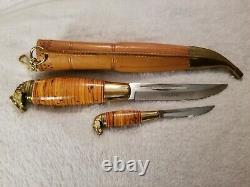
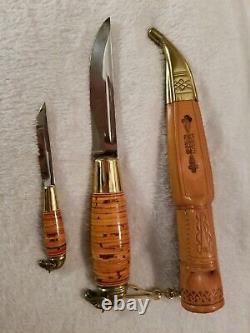
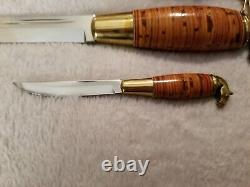
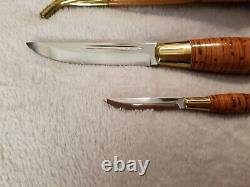
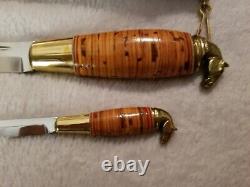
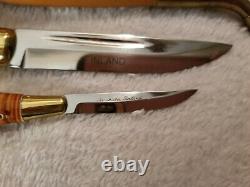
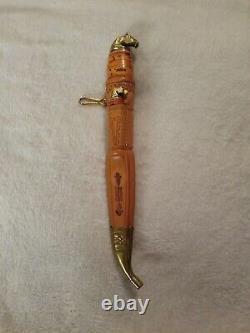
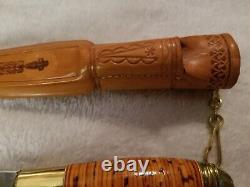
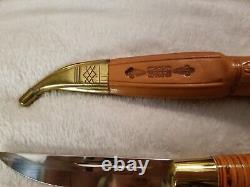
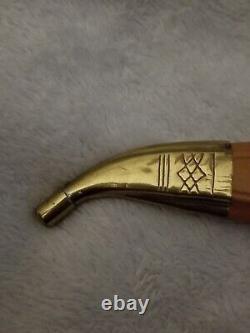
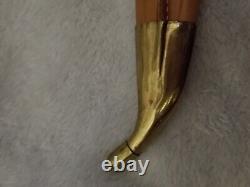
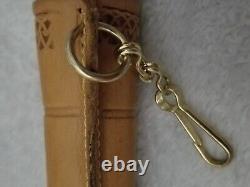

KAUHAVA KNIFE DOUBLE SHEATH HORSE HEAD MADE IN FINLAND SET OF 2 KNIVES. This knife I acquired at a military antique store in Missouri a couple of miles from Fort Leonard Wood. Knife and sheath show no signs of use or sharpening. The blades on each knife are in excellent like new condition.
The handle is made out of birch with brass colored metal base and horse head. Please makepayments within 3 days of the sale. This is the address I will use forshipping.
Your satisfaction is my goal. Please contactme if you encounter any issues with an order so I can resolve them in a timelymanner.Thank you for yourpurchase and please check out my other listings. As an alternative to the traditional Helahoito set there is the beautiful Double Sheath Kauhava Horse Head Knife. The handles of the Horse Head Knives are built up from stacked birch bark layers, and the ferrules are made of brass.
The blades are polished carbon steel. The smaller knife has a 6cm long blade and the bigger one is 10cm. On the natural colored sheath there are traditional decorations and a brass fitting at the tip. IIsakki Järvenpää Company manufactures it's handicrafts themselves from finish materials in their own factory at Kauhava. Materials, machines and working methods have been established decades ago and are currently not planned to be changed. As hilt's materials we mainly use birch, which is delivered to us from Central Finland and Häme. The birch is delivered to factory.As so called scabbard sawn planks, where the planks are dried to exactly right moisture for. Sliced to blocks which are then milled one by one to desired model's shape. During this process the blocks are sorted by birch. Pattern as different model's materials.
Another hilt material that we use is birch bark. Birch bark is being delivered from eastern Finland in 40x50 cm sheets. The sheets are worked one by one to different sizes for different knife models. In birch bark hilt's head accessories we use. And leather in different colors and patterns. Birch bark hilts are crafted one by one, slip by slip for.Every knife's hilt, fully handicrafted. The bark is not glued or otherwise attached to each other, instead they are being held tightly. Together by riveting the whole hilt.
Every knife is grinded individually with. As blade's material we use special knife steel.The steel as material is exception to the domestics of knife because it is delivered. To us by Thüssen Group from Germany in full sheets.
However the materials might very well be delivered to there from Finland. The knife steel has been accurately processed to exact carbon and. Content and this kind of material can't be accessed in. In 1980s blades were hot-forged but back then materials used were old files and even earlier old horseshoes. The carbon quantity for those products were increased by hitting blade with dropping hammer (also known as "heijari"), which.
Removed waste products from the material. Nowdays blades are being pressed from fully uniform and correct mixture ratio steel sheet. Afterwards the blade reforms are tempered and grinded one by one, both sides of the blade individually. In the end blades are polished.
Inaddition we craft knives, scabbards, helavyö and necklaces from complete brass and silver sheet. Individual operations, 3 to 6 different stages each. Naturally the leather of scabbards, belts and necklaces is delivered as whole hides from Central. Hela are all made in singular handicrafts.
Our knives are assembled from aforementioned materials individually in our factory at Kauhava, every single one. Iisakki Järvenpää was born on January 7. 1859, and died on March 6. His father, Juha Heikki, had ended up in Kauhava from Veteli in April 1809, but was originally from Kaustinen.
His mother, Kaisa, was from Lapua. When they met, Kaisa was a widow and a mother of three. Juha Heikki moved to Kaisa's house on the shores of Mäkijärvi lake. They had three children together, the middle one was Iisakki.Iisakki, who was also known as Pikkuluhta, after his childhood home, quickly made his hometown, Kauhava, internationally known with his knives. Even as a child Iisakki was very curious and eager to learn new things.
He learned to read, when Länki-Heikki, travelling horse collar maker, gave him a three-day intensive course. After that he exercised his reading and writing skills on his own. When writing, he didn't just practice how to write, but also perfected his handwriting. His fascination with detailed and uncompromising beauty is not only visible in his knives, but also in his handwriting. Original texts are still on display in the company's shop in Kauhava. One example is Iisakki's signature in the company logo. Iisakki Järvenpää's youth and childhood were marked by the hard times brought on by years of crop failure in Finland. He spent his early years working hard on the fields and in the woods. Iisakki was frailer than the other men in the family, who generally were big and stocky. He wasn't only smaller, but also more sensitive and artistic. However, he still felt that he could do something more demanding. Eventually these thoughts changed the lives of many people, when Iisakki, after having weighed up his possibilities for a long time, announced to his fiancée, Liisa Hirsimäki, on October 20. 1879: I have decided to become a cutler. On that day, a new phase began in his life. It also meant a change in the development of the local history of Kauhava, which still affects to the lives of us, who are continuing his work.He already knew the profession of a carpenter, but he the cutler's skills he had to learn. He learnt everything the hard way, by trial and error, because there wasn't any know-how available, since the whole industry was in its infancy. And so he crafted all his tools on his own.
Still in 2014 those tools are in use at the factory, and during the history we have followed the same practice: made tools by ourselves. By trial and error he had to learn how to forge a blade, how to use alloy, how to harden steel; polishing, sharpening, and all the other phases of knife-making. Moreover, the so-called blood groove on the blade is Iisakki Järvenpää's invention.
Along with knife, its carrying holder took shape, today also known as sheath. Another thing to invent was a belt loop-"kantuumet", as they say in Southern Ostrobothnian dialect of Finnish.These days the existence of all these parts is obvious, but in those days they were just not yet invented. He had tried out and designed all sorts of handles, like we still do in the factory. There are varnished handles, birch bark handles, curly birch handles, even leather ones, etc. All these elements-blade, handle, sheath, belt loop, fittings and finishing-together created hundreds of possible combinations. Hard, uncompromising work and all the trials finally led to increasing appreciation.
However, the real breakthrough was the Knife for Prince Royal (Perintöruhtinaan puukko). The vicar of Alahärmä, F. Durchman, asked Iisakki plenty of times to make a knife for Prince Royal, the future Emperor Nicholas II of Russia (Tsar). In 1888 he finally put his best on the line and began to design and make the knife, which the vicar then delivered to His Highness via Governor General Heiden.Imperial compliments received plenty of nationwide publicity in the press, after which the demand for knives boomed. In many cases the above mentioned Knife of Prince Royal and the Emperor's Knife have been confused. The Emperor's Knives Iisakki produced together with Juho Kustaa Lammi in 1894 for the Emperor Nicholas II and the Empress Alexandra, after having heard about imperial coronation and having gotten excited about it.
Like the Knife of Prince Royal, also these were birch bark handled, horse head pommeled double knives. Along with the gifts, Iisakki received an honorary title, Emperor's Cutler, which was registered in the church record in 1889. Little by little the knife company grew, until after 20 years of working as a self-employed handicraftsman, Iisakki wanted to make things a bit easier for himself and his family.He promised to be a foreman in a newly founded knife factory in Kauhava. He worked as instructor and foreman for five years, until, upon discovering that all promises of salary and housing had proved to be false, he resigned from the job with the support of his oldest son, Juho Nikolai, and founded his own knife company again on the 15. The story continues under the name Iisakki Järvenpää Incorporated Company.
After twenty years of working as a self-employed handicraftsman and a failed five year experiment of working for someone else, Iisakki Järvenpää started again his own knife company in Pukkila, Kauhava, on the 15. The event was advertised in national papers, and at least Vaasa, Uusi Suometar, Päivälehti and Hufvudstadsbladet published the following announcement. To the honoured purchasers and orderers of the Kauhava Knives may the signatory, who is the real founder of present-day knife industry in Kauhava, the first maker of birch bark handled knives, and the producer of the famous Emperor's Knife, having 30 years' experience in the knife industry, honourably announce that since the 1st of day February I have resigned from my position as a foreman in Kauhava knife factory which I held since its foundation, and from now on I will produce all kinds of knives, daggers, etc. Under my own name, and they should be ordered from the signatory. This factory still stands in the center of Kauhava and now serves as Iisakki Järvenpää's historic house museum.
Originally the building was considerably smaller and simpler. It originally functioned both as factory and as family home in 1904 - 1921. The factory and the building along with it were extended numerous times, until the requirements for the factory became too high to realize.
The increasing demand for knives required serial production, and while Iisakki was getting tired, his sons coped well with the expansion and the higher expectations. After his long career of forty years he finally turned his knife company over to his sons and their families on October 15. However, he continued work, instructing and monitoring production quality, until he died on the 6. His son, Juho Nikolai or Jussi, took over the management of the company.
Soon after change of generation, in 1921, an executory sale of bankrupt's estate of Juho Luomanen Osakeyhtiö factory was carried out, including machines and all, in Autio, Kauhava. The factory had produced chandeliers, table lamps, coffee sets, decorative bosses for bedposts, balls, roofing nails, etc. The equipment could be used for knife making either as is or modified. The change took place on October 31. 1921, when Iisakki Järvenpää Incorporated Company was registered. The villagers and boys were amazed and in awe when a huge oddity rolled down the road in September, 1922. The cubs' imagination really took over, when they began to hear a constant pounding from the factory.It was like an iron giant's sledgehammer banging. The indenting hammer is still at the factory on Passinraitti road, but it's not used every day. After all the hard work and financing problems, the factory hit its' stride and grew fast, facing and overcoming numerous difficulties one after another.
In 1935, only six years after Iisakki Järvenpää had passed away, the company lost its' head, Jussi Järvenpää. His brother, Nestori, took the reins. Economical upturns and downturns in economy during recession period and wartime, the beginning of industrialization and many other global events moulded the history of the factory, which was halted by a fire on September 25, 1957.
The fire started from a stove in an engine room and spread rapidly to the ceiling. The personnel rushed in to salvage the machines, risking their lives and even restraining firemen from "ruining the machines". Some bearings were broken by the rescue party, unnecessarily, according to workers. Most of the machines and even some knives and knife parts got salvaged and gathered under the remains of the burned factory building's roof. Plannings for a new factory had already begun under management of Juho Nikolai's son, Allen Järvenpää, in 1951. After the fire, they had to be put in action, and the new factory was built in Passi, Kauhava, where the central heating furnace was lit on September 25. 1958, exactly one year after the fire in Autio factory! Initially the factory was intended to be built on the other side of the river, where the company had already bought a site.An applied planning permit was, however, stopped in the communal process, as the site was said to be too small for the factory. This led to negotiations on the adjacent site of Laitinen, which resulted in signing of a sales agreement on October 24.
New application was made for the planning permit, maybe the new site, which was double the size of the old, would be big enough. However, the local government had planned the site for housing on the quiet, and this was announced together with the rejection of planning permit. That marked the beginning of four years of court proceedings that ended finally in 1955 with forbidding decision from Supreme Administrative Court: the already decided planning must be adhered to. A new site was found adjacent to the church.
The new factory was put under the management of Annikki Kivelä, who was Nestori Järvenpää's daughter. Nestori had been ill for a while, and thus still officially the CEO, but the meetings were held by his sickbed. Nestori passed away at the end of 1960. After her, Mikko Ilmonen took over the reins on May 1, 1988. He had already been actively involved in the production and especially in the product development.
An expression of this is him receiving the 1973 State Prize for Design for his fish knife in wooden sheath. As a prize winner he became one of the grand and famous designers, including Oiva Toikka, Vuokko Nurmesniemi, Yrjö Kukkapuro and Maija Isola.
Because he was an enthusiastic fisherman, he also designed a lure. The product called Tin Fish is not defined as a regular lure but a behavioural decoy for fish of prey.Some few thousand pieces of these were produced in 1975, after which it became clear that the production should be either expanded or ended. So the production of the Tin Fish ended.
In July, 1998, Mikko Ilmonen retired part-time but still worked as a CEO. After a year he fully retired on his own request on July 1. 1999, but he continued as a chairman of the board until his death on November 23.
1999, the company was put under the management of Inkeri Huhtala, who is Iisakki Järvenpää's granddaughter Annikki Kivelä's daughter. Under her management, the company faced the ever-worsening and nearly impossible competition against a growing low-cost production in the Far East that had been growing since the 80's. Little by little working week shortened to two days, and eventually the company faced a daily struggle for survival. For almost two decades had the shareholders been forced to capitalize their family business, and now that road seemed to have reached its end too. The last-ditch attempt was to advertise in the local newspaper, Ilkka that the company was on sale, and only a few days before the company was declared bankrupt, new owners turned up out of the blue: Jarkko Haukkala and Hannu Pennala from Seinäjoki bought the company on August 30.
A new CEO was chosen on the same date. He was Pekka Pollari from Kauhava. By any standard and even internationally, the company personnel must be the most loyal kind. After all the difficulties, when the first owners outside of the family started the operation in the factory, there were 12 employees, out of whom six had served the company for over 40 years and the rest weren't far off the mark.
The whole staff now works full time, five days a week. One employee has retired and a new employee has been taken on.Machinery has been repaired, serviced and overhauled just like in Autio factory in the old days in 1921. Also some renovations of the factory building and repairing of the factory area have been started. All the work is done in the spirit of Nestori Järvenpää, just like in Pukkila in 1919. Product packaging has been made over, certainly by the old ways.
The product range will be brought back as it was, and the production quality will be observed meticulously. This millennium the company bought back the production rights for the Tin Fish lure and its original packaging. Hundreds of original blanks and parts can still be found at the factory, and new lures made of old materials from 1975, packed in their original packages will be produced.
The plan is to also take the legendary fish knife with wooden sheath into production again as a tribute of its designer, Mikko Ilmonen. The history of Iisakki Järvenpää, Iisakki Järvenpää Incorporated Company and the Kauhava Knife until 1979 has already been written down. The company was celebrating its 100th anniversary.The books written in honour of the long history are still available as original editions from the factory outlet and the web store. We write new history every day, but we won't forget the past.
This item is in the category "Collectibles\Knives, Swords & Blades\Collectible Fixed Blade Knives\Vintage Fixed Blade Knives\Factory Manufactured".mariposa" and is located in this country: US. This item can be shipped to United States.- Blade Material: Stainless Steel
- Tang: Full
- Dexterity: Ambidextrous
- Blade Length: 4.1 - 5in.
- Color: Brown
- Blade Edge: Plain
- Modified Item: No
- Vintage: Yes
- Brand: KAUHAVA
- Blade Type: normal straight
- Type: Hunting, Everyday Carry
- Original/Reproduction: Original
- Features: Sheath Included
- Country/Region of Manufacture: Finland
- Handle Material: Leather

